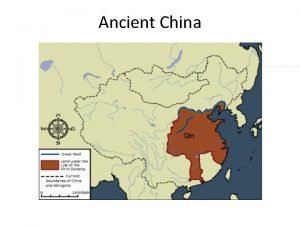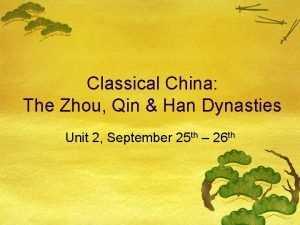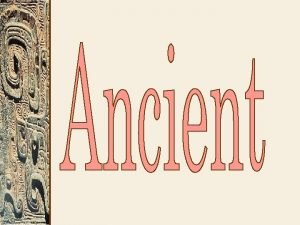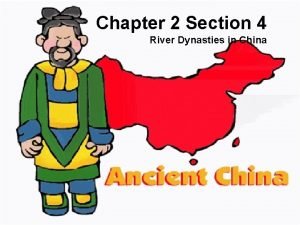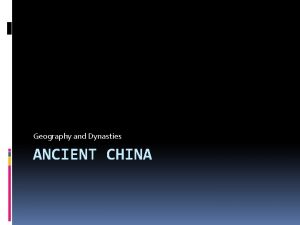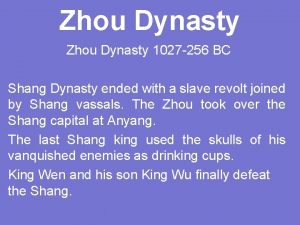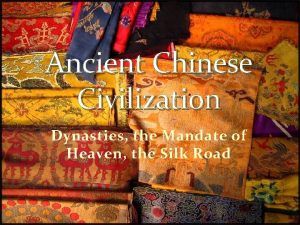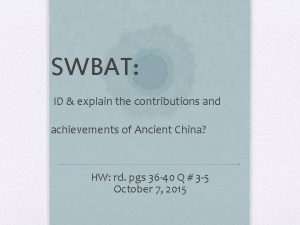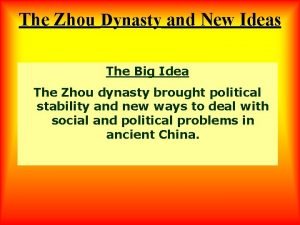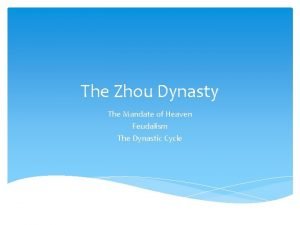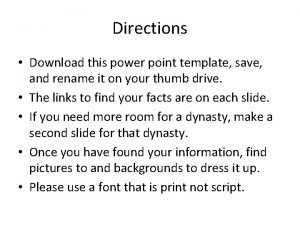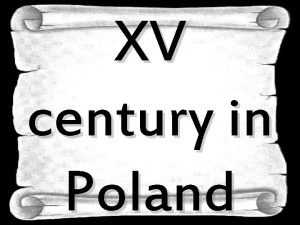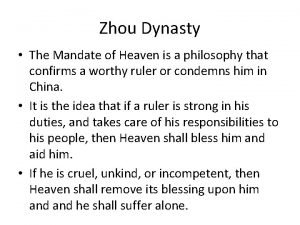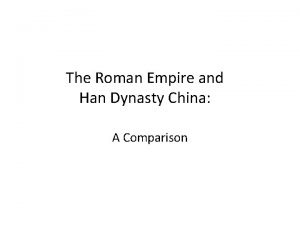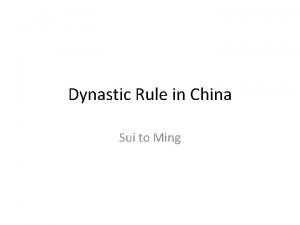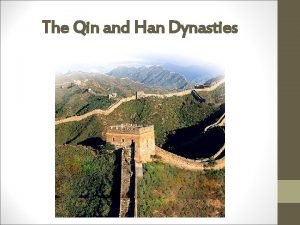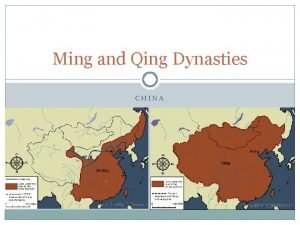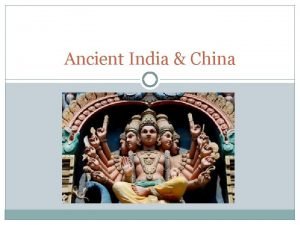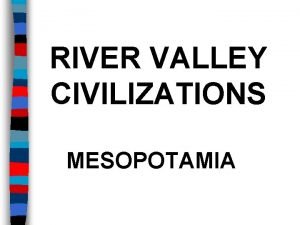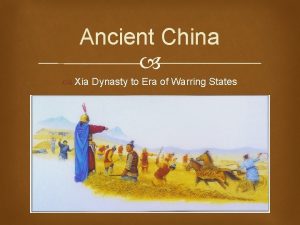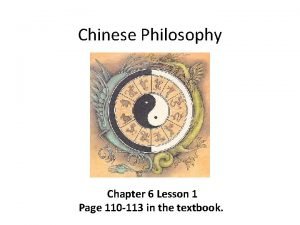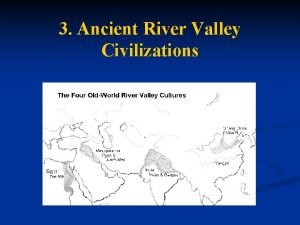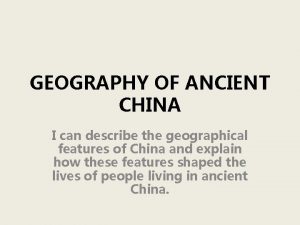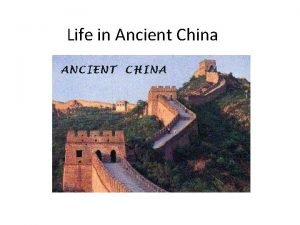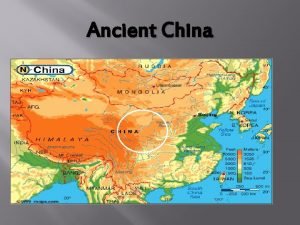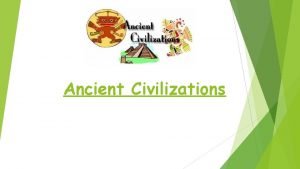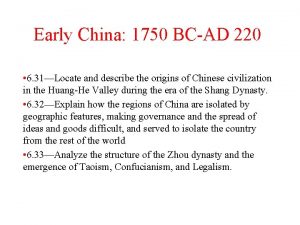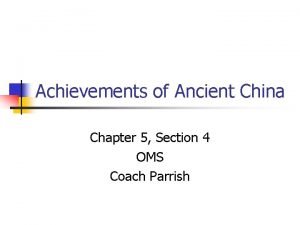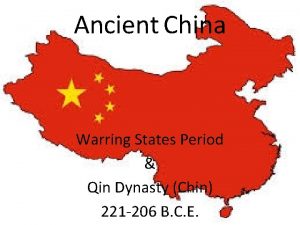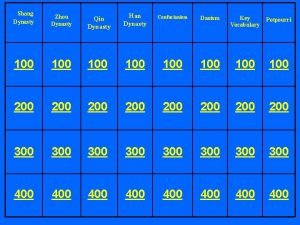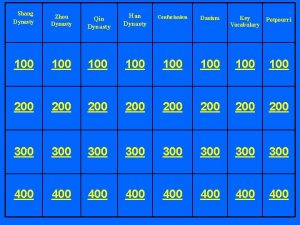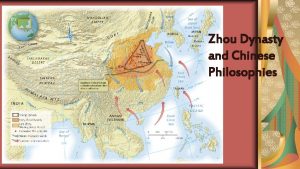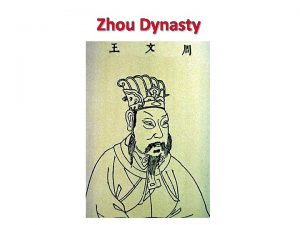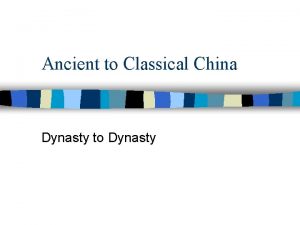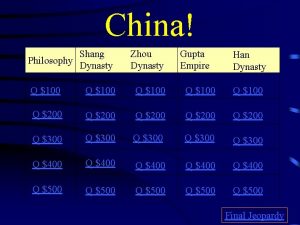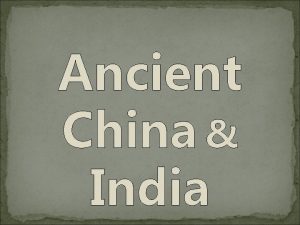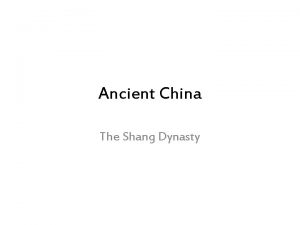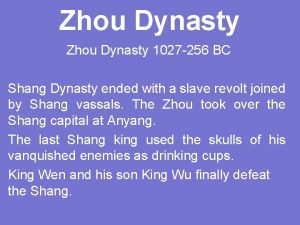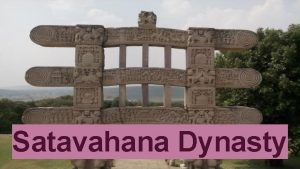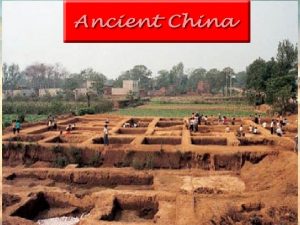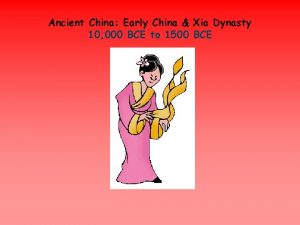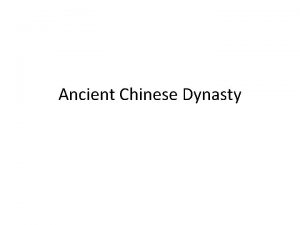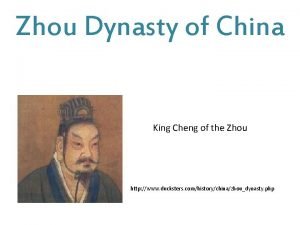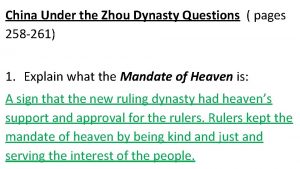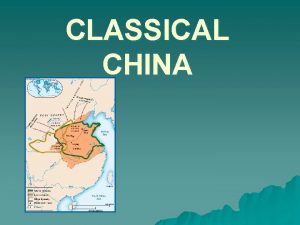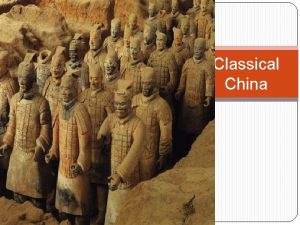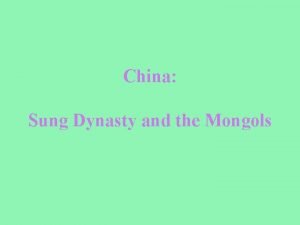Ancient China Eastern Zhou Dynasty The period of








































- Slides: 40

Ancient China

Eastern Zhou Dynasty • The period of 771 – 476 B. C. E. is known as the Spring and Autumn of the Zhou dynasty • Last attempt of Zhou rulers to consolidate and centralize their power • Made governmental reforms in the regions they controlled • Created a system of registering peasants for tax purposes and army conscription

The Warring Years (481 – 221 B. C. E. ) • By 476 B. C. E. only (7) independent states remained • Each claimed the “mandate of heaven” • King Zheng took the title Shi Huangdi • The first imperial dynasty of China

Unification of China • Between 453 – 376 B. C. E. the state of Jin was defeated and divided • War among the remaining states continued between 370 – 319 B. C. E. • By 319 B. C. E. only the states of Qi, Qin, Zhao and Zhou remained • In 256 B. C. E. a Qin army defeated the Zhou

Qin Unite China • In 247 B. C. E. the Qin began the conquest of the remaining states • In 230 B. C. E. conquered the Han • In 225 B. C. E. conquered the Wei • In 223 B. C. E. conquered the Chu • In 222 B. C. E. conquered the Zhao and Yan • In 221 B. C. E. conquered the Qi

Qin as Legalists • In 246 B. C. E. , 13 year old emperor, Shi Huangdi, began to use Legalists ministers to oversee the government • Legalists administrators added stability to the Qin dynasty • Emperor made many Legalists reforms to the empire to centralize his power

Legalists • Developed during the Warring States period • Became the official philosophy of China • Believed human beings are more inclined to wrong than right because of self interest • Believed all other philosophies were a corrupting influence • Writers, teachers and philosophers of other philosophies were executed • Led to great loss of Chinese life and culture

Legalists Reforms • Assigned land to soldiers based on military success • Stripped non-supporting nobility of land rights • Privatized land • Rewarded farmers who met their crop quotas while enslaving those that did not • Gave tax exemptions to supporting nobility

Decline of the Qin Dynasty • The rapid expansion of the empire weakened the dynasty • Qin emperor died in 210 B. C. E. and a struggle for the throne began • Qin dynasty was overthrown by the Han in 207 B. C. E.

The Han Dynasty

Rise of the Han • Replaced the Qin dynasty in 206 B. C. E. under Liu Bang • 2 nd imperial dynasty of China • The emperor was the head of Han society but shared power with ministers and nobles • A prosperous time in China • Promoted Confucianism

Han Dynasty • A time of cultural, political, economic and technological advancements • Dynasty divided into Early and Later Periods • Established trade and political relations with states to the west • Promoted the idea of “dynastic cycle

Dynastic Cycle 1. Begins with internal strife and a new ruler with a “mandate of heaven” that unites the country 2. Economic growth that allows for greater wealth and revenues 3. Public works and projects are widespread 4. The population increases 5. Wars, natural disasters and overspending drain the government’s treasury 6. A period of chaos and rebellions collapse the dynasty and the cycle repeats itself

Han Government • Maintained many aspects of the former Qin government • By the 1 st century B. C. E. the government had over 130, 000 officials • Many officials were recruited or sponsored by a noble for the position they held

The Emperor • He was the center of the Han court • Reigned through the “mandate of heaven” • He issued laws and had the final say in government and court matters • Ministers maintained the functions of the government

Decline of the Han • The death of Wudi in 87 B. C. E. brought on a succession of weak emperors • Local nobles began to assert their power and influence in their regions • Rebellions broke out in 22 B. C. E.

Fall of the Han Dynasty • Han dynasty declined after the Eunuch Revolt and a series of weak emperors • Rebellions broke out in 184 C. E. . • A provincial general installed a new emperor and killed the Empress and court eunuchs in 190 C. E. • The Han dynasty collapsed in 220 C. E. , leading to the period of the three kingdoms

The Han Legacy • Han scholars reconstructed the lost text of Confucius • A dictionary with over 9000 characters created a common written language in 100 C. E. • Han philosophers studied and taught cosmological naturalism

The Spread of Religion • A resurgence of Buddhism and Daoism occur after the fall of the Han dynasty • Both religions were spread along the trade routes across China • By the 5 th century C. E. , Buddhism had spread throughout China and was favored by the emperors

20

The Roman Empire

Founding of Rome • Founded on the (7) Palatine Hills overlooking the Tiber River around 753 B. C. E. by Romulus • Mythology states Romulus and his brother, Remus, were raised by a she wolf • Established as a kingdom around 600 B. C. E. • Ruled by kings until 509 B. C. E. when a republic was established

Roman Government • Headed by an elected for life king • The Senate, which was made up of nobles, wielded great power as they held control over many aspects of Roman life • The Assembly was a representative body for the commoners

Establishment of the Republic • Established around 509 B. C. E. after the tyrant Tarquin was deposed • A constitution was established with the government ran by (2) consul magistrates and an assembly • The power of the Senate was extended with the Republic • Patricians held the power of government • Plebeians expanded their power through the army

Punic Wars • Carthage and Rome come into conflict in 264 B. C. E. over the cities in Sicily • Carthage was a sea power while Rome was a land based power • Rome eventually builds a strong navy and defeats the Carthaginian fleet • Two decades of fighting Rome gains control of Sicily, which led to peace in 241 B. C. E.

Second Punic War • Rome formed an alliance with Saguntum, a city under Carthage control in Spain in 220 B. C. E. • City was recaptured by Hannibal in 219 B. C. E. • War broke out between Carthage and Rome again in 218 B. C. E. • By 216 B. C. E. Hannibal had defeated (3) Roman armies in Italy

Aftermath of Second Punic War • Carthage gave up its claim to Spain and areas of North Africa • Carthage gave up all but 10 of its ships • Carthage could not maintain a standing army without the consent of Rome • Rome gained control of the Mediterranean Sea

Rome and Philip V of Macedon • Rome moved against Philip V of Macedon in 214 B. C. E. • Rome was joined by the Aetolian League of Greek city – states • Peace was declared in 205 B. C. E. after six years of fighting

Second Macedonian War • Rome declared war on Philip V in 200 B. C. E. due to his efforts of conquest in Greece • In 198 B. C. E. Rome demanded Philip V to remove his forces from Greece • A Roman and Greek army defeated Philip V at the Battle of Thessaly in 197 B. C. E. forcing Philip to sue for peace

Third Macedonian War • Rome declared war on Perseus, the king of Macedonia in 171 B. C. E. • The Macedonian army under Perseus was defeated by Rome at the Battle of Pydna in 168 B. C. E. • Rome divided Macedon into four different republics

The Roman Republic about 100 B. C. E.

Lucius Cornelius Sulla • Elected consul in 88 B. C. E. • A supporter of the Senate • Involved in a civil war with Gaius Marius for control of Rome • Appointed himself dictator of Rome in 82 B. C. E. , leading to the end of the Republic of Rome

Gaius Julius Caesar • Born around 100 B. C. E. • Joined the 1 st Triumvirate in 60 B. C. E. • Given the governorship of Illyrium and Gaul in 59 B. C. E. • Appointed dictator of Rome in 45 B. C. E. • Assassination of Caesar lead to 13 years of civil war in Rome

Octavian • Defeated the assassins of Julius Caesar at the Battle of Philippi in 42 B. C. E • Gained control of the western Roman Empire • Defeated the army and navy of Anthony at the Battle of Actium in 31 B. C. E. • Occupied Egypt in 31 B. C. E. making it a Roman province

Reforms and Expansion of Rome by Augustus (Octavian) • Began reforms of Roman government, society and army • Annexed Egypt, northern Spain, Judea, and areas in North Africa • Given the title “Augustus” by the Senate making him the 1 st Roman Emperor • Implemented public works projects

Successors of Augustus • • Tiberius ruled from 17 – 37 C. E. Caligula ruled from 37 – 41 C. E. Nero ruled from 54 – 68 C. E. Vespasian ruled from 69 – 79 C. E. Trajan ruled from 98 – 117 C. E. Hadrian ruled from 117 – 138 C. E. Marcus Aurelius ruled from 161 – 180 C. E.

Rome and Christianity • Jesus was born in Judea in 4 B. C. E. • Jesus became a leading teacher in Jewish prophecies • He was viewed as a “messiah” or savior • Arrested, tried, convicted and crucified in 30 C. E.

The Spread of Christianity • Paul of Tarsus carried on the teachings of Jesus • Paul traveled throughout regions of the Roman Empire spreading the words of Jesus • Paul was arrested for treason in 57 C. E. • Paul was tried, convicted and beheaded in 62 C. E.

Rome Under Constantine • Gained control of the Roman Empire in 312 C. E. • In 330 C. E. established his capital at Constantinople • Made Christianity the religion of the empire in 321 C. E. • In 335 C. E. permanently divided the Roman Empire

Barbarian Invasions of Rome • By 360 C. E. barbarian tribes were raiding Roman territory • In 376 C. E. the Goths invade the Greek provinces • In 410 C. E. , the Goths under Alaric I sack Rome • In 476 C. E. Romulus Augustus, the last Roman Emperor in the west, was deposed
 Ancient china zhou dynasty
Ancient china zhou dynasty Zhou dynasty wars
Zhou dynasty wars China zhou dynasty
China zhou dynasty China zhou dynasty
China zhou dynasty Sui dynasty achievements
Sui dynasty achievements Chapter 2 section 4 river dynasties in china answer key
Chapter 2 section 4 river dynasties in china answer key China dynasty
China dynasty Zhou dynasty achievements
Zhou dynasty achievements Zhou dynasty achievements
Zhou dynasty achievements Contributions of the shang dynasty
Contributions of the shang dynasty The zhou dynasty and new ideas
The zhou dynasty and new ideas The huang valley
The huang valley Zhou dynasty mandate of heaven
Zhou dynasty mandate of heaven Facts about the qin dynasty
Facts about the qin dynasty Zhou dynasty map
Zhou dynasty map Mandate of heaven zhou dynasty
Mandate of heaven zhou dynasty Ancient india vs ancient china
Ancient india vs ancient china Both the han dynasty and the roman empire
Both the han dynasty and the roman empire How did the ming dynasty restore chinese rule to china?
How did the ming dynasty restore chinese rule to china? China history timeline
China history timeline How was china reunited under the sui dynasty?
How was china reunited under the sui dynasty? How did the sui dynasty affect daily life in china
How did the sui dynasty affect daily life in china China qin dynasty map
China qin dynasty map Ming dynasty time period
Ming dynasty time period Primitive physical activities
Primitive physical activities 322-185
322-185 Ancient china social class
Ancient china social class Complex institutions in mesopotamia
Complex institutions in mesopotamia Engineering an empire china
Engineering an empire china Ancient china craftsmen
Ancient china craftsmen Lesson 1 schools of thought in ancient china
Lesson 1 schools of thought in ancient china Mansa musa accomplishments
Mansa musa accomplishments River valley civilizations definition
River valley civilizations definition China geography
China geography Aristocrats in ancient china
Aristocrats in ancient china Physical map of ancient china
Physical map of ancient china Ancient china confucius
Ancient china confucius 1750 bc ancient china
1750 bc ancient china Achievements of china
Achievements of china How long ago was ancient china
How long ago was ancient china Ancient china people
Ancient china people

